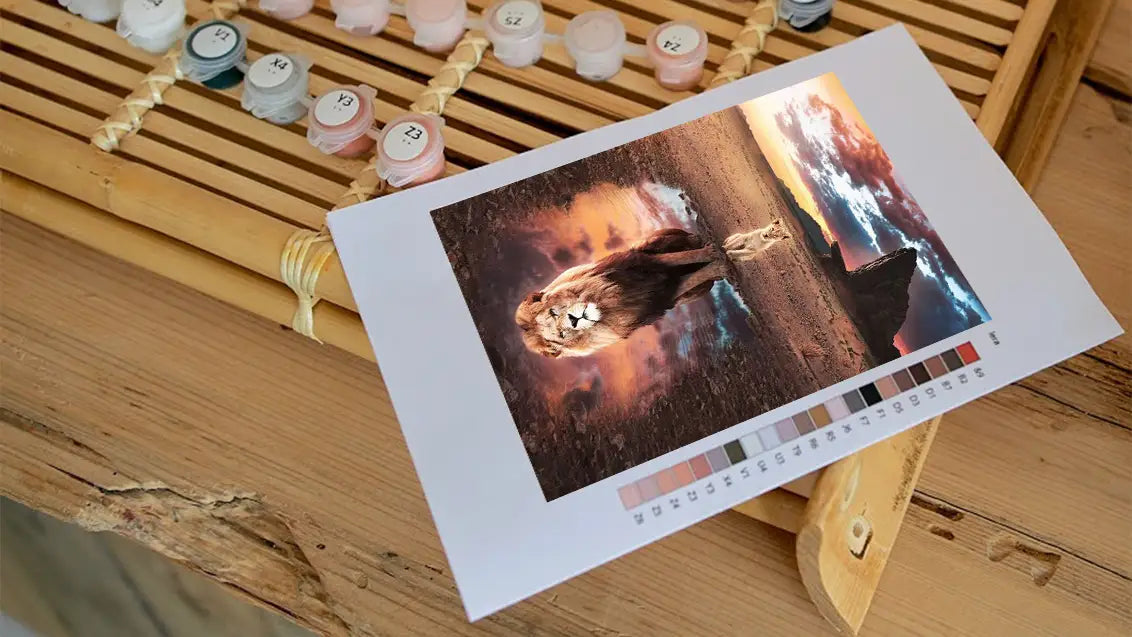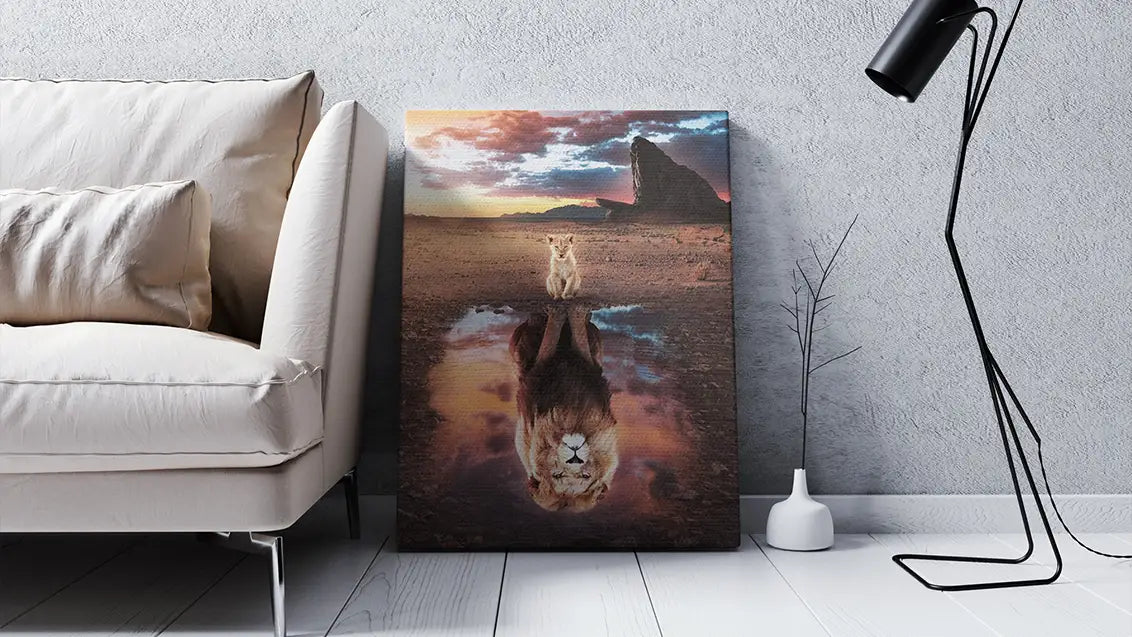
Roar to Life: The Ultimate Guide on How to Paint a Lion
Lions, creatures of raw power, awe inspiring beauty and undeniable authenticity…. painting a fascinating portrait of a lion can let you step into the relentless world of artistic expression where you can capture the golden mane, authoritative expression of its eyes and lion’s nature on canvas. Such lion paintings on canvas are not merely a work of art but it is a journey to the wild.
So, fellow artists and adventurers, gather your paints, ready your brushes, and join me as we navigate the golden plains of creativity. Let's paint a lion that roars not only in color but also in the echoes of untamed wilderness—a masterpiece that celebrates the indomitable spirit of the king of beasts. Get ready to unleash your creativity and witness the painting of a lion come alive with the wild magic of a painted lion.
Lion Paintings
Lion artwork, an enchanting category, depicts the majestic and powerful essence of these royal animals. Artists employ various techniques, ranging from lifelike portrayals to imaginative renditions, showcasing lions in their natural surroundings or emphasizing their symbolic power. Whether highlighting deep emotions or exploring symbolism associated with these creatures, this collection of artworks serves as a grand tribute to the splendor of lions while also providing a wide range of artistic interpretations.
Supplies Needed for Lion Paintings:
- Canvas or painting surface
- Acrylic or oil paints
- Paintbrushes of various sizes
- Palette for mixing colors
- Palette knife
- Water or paint thinner
- Easel
How to Paint a Lion: Steps!
Step 1: Gathering Reference Images

Gather a diverse range of reference images capturing lions in various poses and environments. Observe their majestic features, intricately defined manes, and the way light gracefully illuminates their fur from different angles. Immerse yourself in these captivating visuals to deeply understand the essence of lions and elevate your lion canvas painting with authentic accuracy.
Step 2: Sketch the Lion
Begin by lightly sketching the outline of your canvas using a pencil. Take care to meticulously capture the intricate details of various features, such as the majestic head, flowing mane, and graceful body. Mindfully focus on ensuring that proportions and positioning are accurately represented in your preliminary sketch.
Step 3: Choose a Color Palette
Take careful consideration in selecting a color palette for your magnificent lion. These regal creatures are commonly adorned with various hues of warm tan, rich brown, and lustrous gold. Take inspiration from the natural lighting conditions depicted in your reference images to truly capture the exquisite and authentic tones that bring this majestic creature to life.
Step 4: Block in the Background

Consider incorporating a captivating backdrop for your majestic lion. Introducing a tastefully crafted background can elevate the overall artistry of your abstract lion painting, offering both contextual richness and an immersive atmosphere.
Step 5: Block in Base Colors
Start the paintings of lions by initially blocking in the base colors of the majestic lion. Utilize bold, sweeping strokes to establish a captivating and harmonious color palette that will set the foundation for your artwork's visual impact. At this stage, focus on capturing broad shapes rather than intricate details, allowing you to develop a sense of depth and dimension as you progress further into your creation.
Step 6: Define Shapes and Features

As you continue working on your easy lion painting, take the time to carefully define and shape each aspect. Pay close attention to every detail, such as the eyes, nose, mouth, and most importantly, the unique characteristics of its majestic mane. Allow yourself to add multiple layers of paint in order to create rich depth that brings your artwork to life.
Step 7: Add Detail to the Mane
The majestic lion's mane is a captivating sight, its voluminous tendrils cascading down with an air of regality. Incorporate meticulous brushstrokes to convey the intricate texture, paying special attention to the juxtaposition of soft wisps and coarse strands. Experiment with a palette knife for an added dimension and depth that beautifully emphasizes the untamed nature of this awe-inspiring feature.
Step 8: Refine Facial Features
To enhance the facial features of lion colorful painting, consider incorporating more depth and dimension. Pay attention to details such as highlights and shadows in order to bring out the captivating aspects of the eyes. Additionally, dedicate time to refine the structure of both the nose and mouth, taking into account their anatomical proportions for a more refined look.
Step 9: Highlight and Shadow
Bring attention to the intricate details of the facial features. Enhance the depth and expressiveness in the eyes by skillfully intertwining highlights that bring out their radiance, as well as shadows that infuse a sense of mystery and intrigue. Pay meticulous attention to refining every subtle aspect of both the nose and mouth, ensuring an impeccable portrayal that effortlessly captures their complex anatomical intricacies.
Step 10: Final Touches
Step back from your lion painting easy and engage in a thorough evaluation, allowing yourself to be completely absorbed by it. Take the opportunity to meticulously examine every intricate element and contemplate whether any additional tweaks or enhancements might be warranted. It is crucial that you meticulously compare these intricate elements with your reference images to ensure perfect alignment.
How to paint a lion - Tips:
- Use warm, earthy colors like browns, oranges, and yellows for the lion's coat.
- Use a variety of brushes to achieve different textures, especially for the mane.
- Build up your lion art paintingin layers. Let each layer dry before adding the next for better color depth.
- Step back periodically to avoid overworking the lion acrylic painting.
- Pay attention to the light source for realistic placement of shadows and highlights on the lion's body.
- Be patient and allow for experimentation, understanding that improvement comes with practice.
- Spend time refining details, adding intricacies to the mane, whiskers, and facial features.
Summing Up
As we come to the end of our artistic journey through how to paint a lion, it’s time to pause and truly immerse yourself in the captivating beauty of your vibrant masterpiece. Painting lion goes beyond mere replication; it is an opportunity to infuse your creation with the very essence of untamed majesty. With each deliberate brushstroke, you have woven together a visual narrative that embodies both strength and beauty—a testament to your artistic prowess that deserves jubilant celebration.
As an artist, whether experienced or new to the craft, let your lion roar with pride on the canvas. Let it symbolize your profound connection to the untamed spirit of nature. Remember that this chapter is just a stepping stone in your artistic journey of lion painting on canvas. The world of art is expansive and holds endless possibilities for you to explore and breathe life into new wonders on your canvas.
So keep pushing boundaries, keep unleashing your creativity, and allow the resounding roar of your artistic spirit reverberate through every stroke you make with lion paint by number kits from Pets by Numbers.

